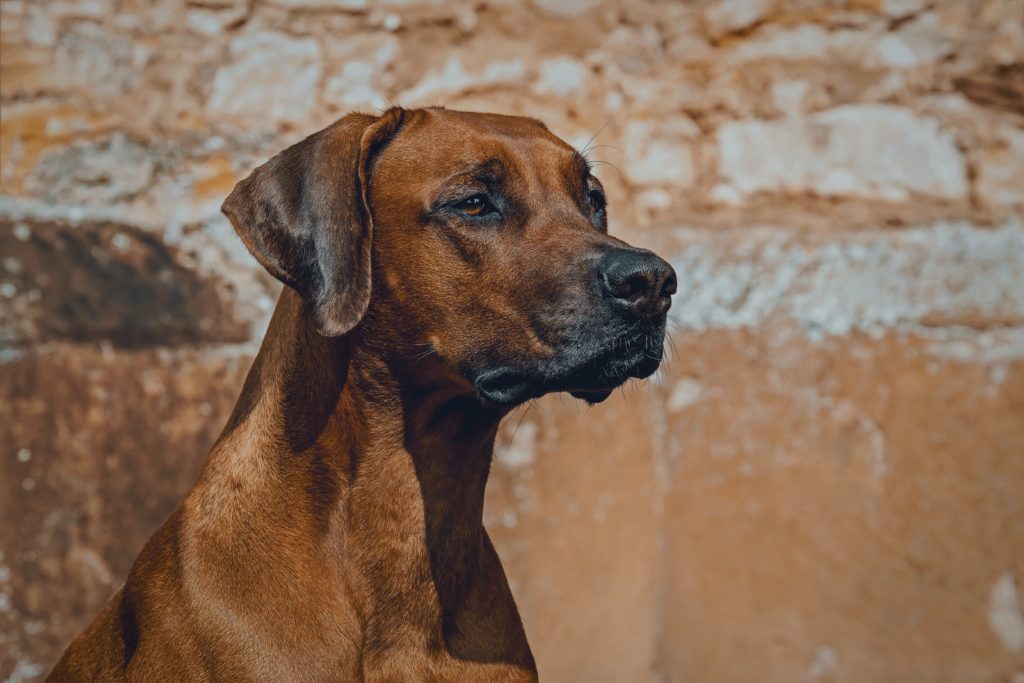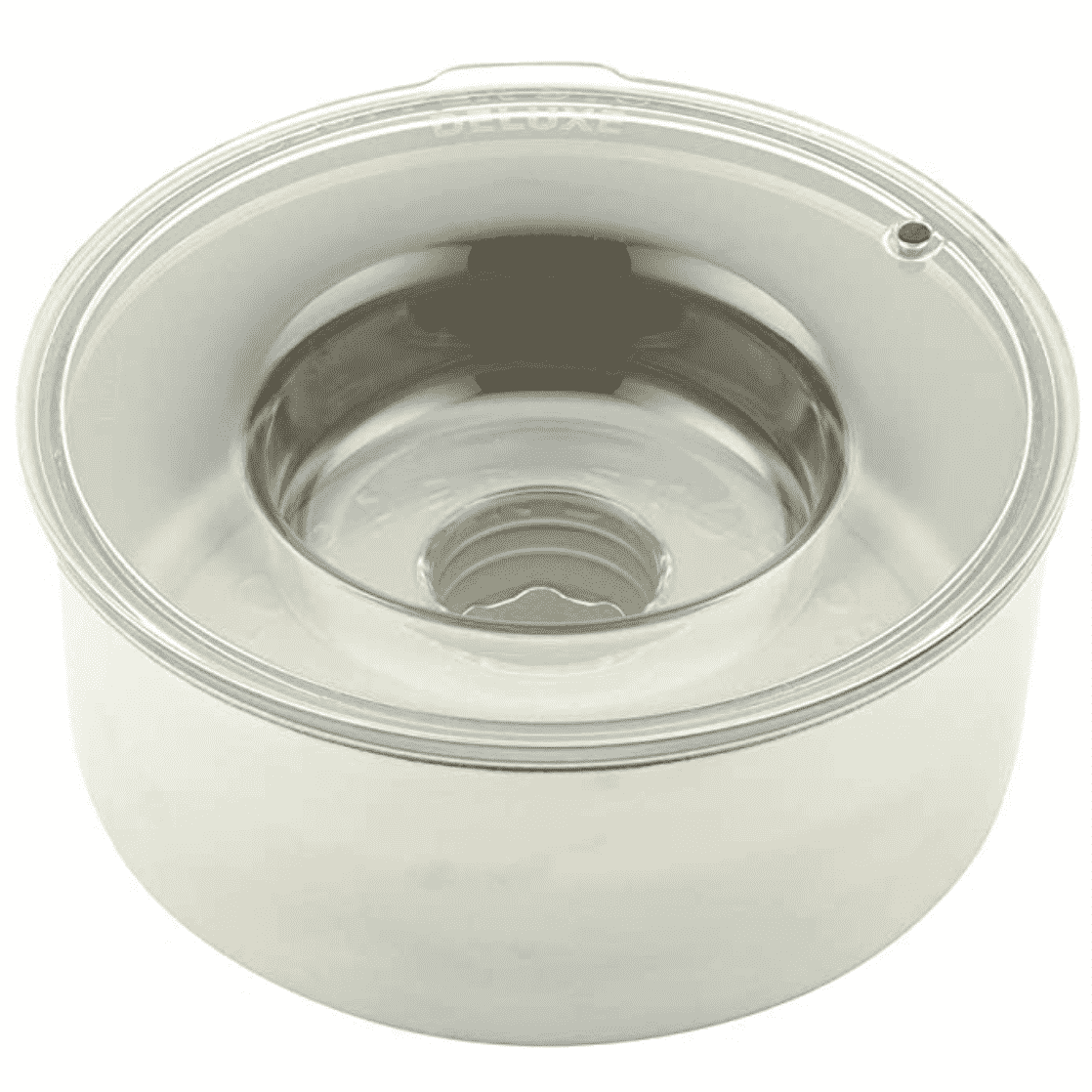
Energetic and active as puppies, the Rhodesian Ridgeback matures into a calm dog with fairly moderate exercise needs. This means they can adapt well to even apartment living. However, it should be noted that they are considered to be large dogs. What does that mean? Well, let’s take a look at Rhodesian Ridgeback size and just how big they can get.

Our handy interactive puppy growth chart and calculator takes all the hard work out of predicting your puppy’s potential adult size. This helps you to know exactly what you are in for.
Psst! Check Out These Awesome Puppy Things!
Rhodesian Ridgeback Size Predictions by Age
Named for the ridge of backward growing hair down their spine, Rhodesian Ridgebacks, once referred to as the African Lion Hounds, are every bit as impressive as they sound. Not particularly well known within the US, these wheaten-colored ‘Renaissance Hounds’ are great for those looking for a confident, athletic, intelligent dog that is trainable in a variety of ways.
Smart, even-tempered, and exuberant, Rhodesian Ridgebacks make great family pets but do require an experienced owner. They are super intelligent and can be trained to an extremely high level. However, this, combined with their working dog background, means they are stubborn, independent pups with a high prey drive. RRs can be aggressive towards animals they aren’t familiar with.
Initially bred as hunting and home guardian dogs, Ridgebacks were later used to track and hold big game at bay until the hunters arrived. This included boars, bears, and even lions. These are big, powerful dogs! For this reason, they need a firm and consistent hand from a very young age and plenty of early socialization.

As adults, they make quiet, gentle, and protective companions who can be a little wary of strangers but great with kids. Their coat doesn’t require much maintenance, but these dogs do need plenty of attention and mental stimulation. When bored, they can become destructive.
In terms of size, Rhodesian Ridgebacks grow upwards very quickly and outwards at a slightly slower rate. Specifics can be seen below:
| Age | 3 months | 6 months | 1 year | Adult |
| Weight | 25 – 30 lbs | 40 – 45 lbs | 50 – 75 lbs | 70 – 85 lbs |
| Height | 10 – 12 inches | 17 – 19 inches | 23 – 25 inches | 24 – 27 inches |
*A dog’s height is measured from its withers – this is the point between the shoulder blades.
These dogs reach their full size somewhere between 14 and 18 months, depending on how large they are at their final size. Naturally bigger, more muscular (usually male) dogs will take longer to get there. Some may even continue gaining in muscle mass right up until there are two years of age.
Are There Different Sizes of Rhodesian Ridgeback?
There are a few different types of Ridgeback (Phu Quoc, Thai), but they are considered distinct breeds. A few similar genes cause this interesting feature for which they are named, but these dogs are otherwise very different.
As is the case with most larger breeds, though, there are differences in both height and weight between the male and female RR. Males are a little larger at 25 to 27 inches tall and around 85 pounds. Females are slightly smaller at 24 to 26 inches and about 70 pounds.

Rhodesian Ridgeback Growth Patterns
Like most larger dogs, Rhodesian Ridgebacks grow rapidly in the first six months of their lives. By the time they are just 3 months of age, they are already at almost half of their adult height – although they have a long way to go in terms of weight. At 6 months, though, they have achieved around 75% or more of their adult height and at least half their adult weight.
These dogs typically reach their full size somewhere between 14 to 18 months. However, they will have gotten to their adult height somewhat earlier than that. They will continue to gain muscle mass for a while. How much depends on their genetics (how large and heavyset their parents are), as well as their gender, diet, and exercise levels. Working dogs and ones used for canine sports may continue to gain this kind of weight well into their second year.
Additionally, this is why it’s particularly important that your Rhodesian Ridgeback puppy gets the correct nourishment he needs to grow that adorable little body into a healthy adult one. Check out these guides on best dog food for puppies here.
How Big is a Full-Grown Rhodesian Ridgeback?
Depending on all of the above, a Rhodesian Ridgeback will grow to around 24 to 27 inches to the shoulder. They will weigh somewhere in the region of 70 to 85 pounds. This places them firmly in the large dog category.

Rhodesian Ridgebacks usually get to half their total weight around 5 – 6 months and their adult size at roughly 14 – 18 months.
You can calculate their potential adult weight at 23 weeks by taking what they weigh at that age and multiplying it by two.
A different formula you could use is:
- Growth = current weight / current age in weeks
- Adult weight = Growth x 52 (number of weeks in one year)
So, for example, if your 12-week old pup weighs 18 pounds. You simply divide the current weight by their age in weeks and multiply the result with 52:
18/ 12 = 1.5
1.5 x 52= 78 pounds
78 pounds would be the expected weight of your adult-sized Rhodesian Ridgeback.
At What Age is a Rhodesian Ridgeback Fully Grown?
Like all large breeds, the Rhodesian Ridgeback is considered fully grown at 18 months. Although female dogs and males on the smaller size will be there by the time they are 14 months. The breeder should be able to tell you a little more about what to expect in terms of whether your pup is likely to be at the larger or smaller end of the scale. A lot of this is passed on from their parents, grandparents, etc.
Pay close attention also to the way that your puppy is growing and how they sit within the standards at each milestone age (as outlined above). For a more specific estimate of your puppy’s potential adult height, check out our handy interactive puppy size calculator.
Rhodesian Ridgebacks aren’t currently one of the most popular types of family dog, but that is likely to change as more people hear about these happy hounds. They make wonderful pets for active people who are willing to put the early work in with them. If you have recently heard about these dogs and are curious to know how big they grow, hopefully, the information included in this article addresses that question and a bit more besides.
Pin It!







